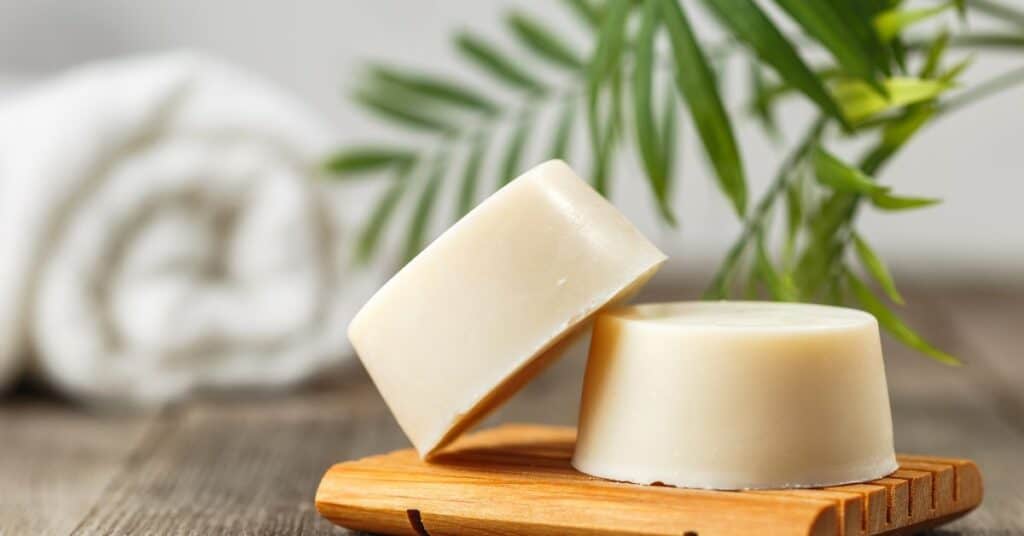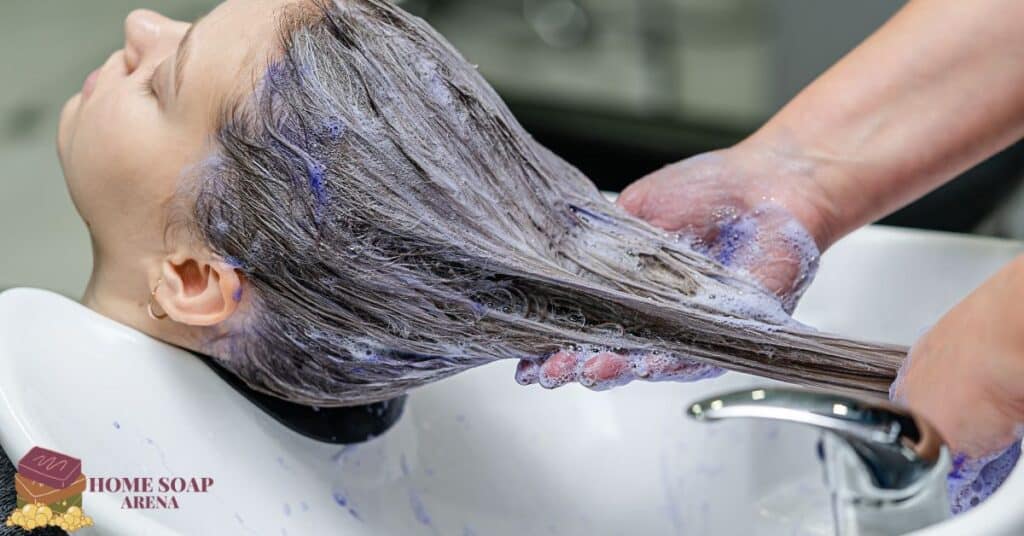Table of Contents
- What Is The Difference Between Shampoo And Soap?
- Is soap better than shampoo for hair?
- Should You Wash Hair With Soap?
- Tips for Using Bar Soap on Hair (If You Choose To)
- Can You Use Shampoo Like Soap?
- Conclusion
Is there a difference between shampoo and soap? Yes! As a soap maker, I adore natural cold-process soap, but definitely not for my hair.
With foaming soap bars that mimic shampoo bars and vice versa, It is easy to wonder if soap and shampoo are that different these days.
Up until the 1930s, it was standard practice to use bar soap on the hair. Both come in liquid or bar form, scented or unscented, colored or clear.
Shampoo cleans your hair and scalp, while soap is meant to clean your skin and the hair on your body and wash your hands.
However, should regular soap and shampoo be used interchangeably? Does soap bar cause hair loss?
In this blog post, we will explore the differences between shampoo and soap and why they are not the same.
Let’s Start!
What Is The Difference Between Shampoo And Soap?
While sodium lauryl sulfate is used in most soap and shampoos to remove dirt and grease and clean in the same way, it doesn’t mean they’re the same.
They both have different usages, so their formulas are different.
They have different PH.
Soap bar is made through saponification, a chemical reaction combining a fatty part.
-animal or oil (e.g., olive or coconut oil) reacts with sodium hydroxide (lye) to produce glycerin and salt.
Sodium of the oil (e.g., sodium olivate or sodium cocoate), which we call soap. The soap has an alkaline PH of at least 7 or 9, and hair is between 4.5 and 5.5.
Plus, some handmade soap bars contain ingredients that might not be suitable for hair, like dry herbs, fruit, and oatmeal, which can easily cause fizz to the hair, particularly the black African American hair type (which happens to be my hair type) that is easily prone to tangle.
When you use a soap bar to bathe, you are not directly rubbing it on your skin but on your sponge instead, except for the face.
However, when washing the hair, you have to put it directly on it, and those herbs in the soap tend to cause friction on the hair strands.
Unlike soap bars, shampoo bars are often smooth. You seldom find them with swirls or dried herbs as designs on them.
A solid shampoo is made with vegetable surfactant (SCI) Sodium Cocoyl Isethionate,
which is readily biodegradable, and also a sustainable option and has a PH between 4.5 and 5.5 (acidic), equal to the scalp’s PH.
Shampoo is formulated especially for hair, with less detergent than soap or a detergent-free surfactant.
It also comes packed with additional hydrating, nourishing ingredients for healthier hair over time.
Soaps also exert this effect; however, their alkaline pH makes them unsuitable for use on our hair.
Is soap better than shampoo for hair?
No! Have you noticed that when you use a thing or product for its main purpose, it tends to work effectively, and you get results quicker than when using it for another purpose where it works but wasn’t originally created to function there?
Now, let’s bring it into soap and shampoo bars or liquid shampoo.
When we wash our body with soap, it rinses easily from the skin, and the skin’s natural acid mantle is quickly restored.
(thanks to combining the skin’s natural oils and beneficial bacteria). However, something different happens in hair.
When a product with a pH above 7 touches the hair shaft, it causes the cuticle (which covers the shaft) to open.
The result is frizzy, weak, dry, and rough hair. If it is dyed, the color falls off quickly, and a grimy “film” forms that settles on the head.
This is why many people do not like solid shampoos and often never try one again as a result of buying a soap framed to be a shampoo bar.
There are several types of hair; you might need to do some trial & error to find what works best for your hair.
Even when using the right product, there’s still a way to use it to get your desired result. In this case, to get the desired result, there is a way to wash hair with shampoo bars.
So, how do you distinguish between one and the other? One way to differentiate between the two products is by reading their ingredient lists.
It is an excellent indication that it is a soap bar if it contains sodium hydroxide and oils such as olive, coconut, or castor among the first ingredients.
Soap bars with pumice, flower pedals, or coffee grinds would not rub through your hair well.
While soap tends to be less specialized than shampoo, soap manufacturers have
expanded their product lines to contain products with moisturizers, conditioners, and fragrant scents.
But- it is impossible to make the soap with a low-acidic pH.
Solid shampoo is similar to solid soap in its manufacturing process. It is produced from natural ingredients such as essential oils, plant extracts, and mild surfactants.
Soap-free shampoo bars do not undergo a saponification process and, therefore, are soap-free.
These bars use surfactants, conditioners, and hair-loving ingredients, such as panthenol, nourishing oils, and botanicals.
Sodium coco sulfate (SCS) and sodium cocoyl isethionate (SCI) are surfactants (washing agents) of plant origin derived from the fatty acids of coconut oil.
It is the main raw material used to manufacture our shampoo bars.
Shampoo bars usually have more castor oil, babassu oil, coconut oil, and jojoba oil than soap bars.
These ingredients are combined with water to produce a solid shampoo to wash hair.
Should You Wash Hair With Soap?
Pros of Applying Soap on Hair
Sometimes, it contains Natural Ingredients
Cost-Effective: Soap bars can be more cost-effective than specialized shampoos, especially if you opt for simpler formulations or make your soap.
Cons of Applying Soap on Hair
pH Imbalance: Most traditional soaps have a high pH (alkaline), which disrupts the natural pH balance of the scalp and hair. This leads to dryness, frizz, and potential damage over time.
Residue Buildup: Soap residues may accumulate on hair strands, causing dullness, heaviness, and difficulty styling.
Lack of Hair-Specific Ingredients: Soaps lack the specialized ingredients in shampoos, such as conditioning agents, UV protectants, and scalp-nourishing components.
Hard Water Reaction: In areas with hard water (high mineral content), soap bars can create soap scum and leave hair feeling sticky or unclean.
On the other hand, with shampoo bars or liquids, you seldom see soap residues on the hair.
Tips for Using Bar Soap on Hair (If You Choose To)
Choose Mild Formulations: Opt for mild, natural soap bars with moisturizing ingredients like olive oil, coconut oil, or shea butter.
Some people say to use an acidic rinse. I’m indifferent about that option because you must take into consideration your hair type and the dislikes of your hair.
If you are in a location, phase, or season of your life where soap is the only option, use soap on your hair occasionally rather than daily to minimize potential damage and buildup.
Can You Use Shampoo Like Soap?
Using soap instead of shampoo to wash your hair, you will notice some negative consequences, such as:
Your hair is very sensitive to changes in pH and likes to remain acidic. Hair reacts both to acids and alkalis. Each strand has little cuticles, like scales.
Acid makes the scales flat, making your hair shiny and smooth.
On the other hand, Alkali makes the scales stand up, making your hair look dull, rough, and tangled.
Soap scum: Soap leaves behind a white, sticky residue on your hair, especially if you have hard water. This can make your hair look dull, greasy, and dirty.
Frizz: Soap strips away the natural oils and moisture from your hair, making it dry, brittle, and prone to frizz and breakage.
Scalp irritation: Soap disturbs the natural pH balance of your scalp, making it more alkaline and susceptible to irritation, inflammation, and infection.
Breakdown of proteins, causing any natural curl or wave pattern to deteriorate
Shampoos are also formulated to be delicate, able to cleanse without degreasing, easy to rinse out, and prepared to minimize eye irritation.
Color fading: overtime, Soap fades away the color of your dyed or natural hair, making it look dull and lifeless.
On the other hand, using shampoo to wash the skin leads to consequences, such as:
Oiliness: Shampoo leaves behind a thin layer of oil on your skin, making it look shiny and greasy.
Clogged pores: Shampoo can clog your pores, trapping dirt, oil, and bacteria inside. Potentially leading to acne, blackheads, and whiteheads.
Skin irritation: Shampoo contains ingredients that are too harsh or gentle for your skin, causing irritation, dryness, or allergic reactions.
Even if you’re tempted to use shampoo on your skin instead of soap, you’ll find that it often leaves your skin feeling slimy.
Soap or liquid soap is formulated with stronger detergents for your skin, which can often contain more oil and dirt than your hair usually does.
Some products may even claim to be an all-in-one combination of shampoo, conditioner, and soap.
If you use these products, though, just be aware that they might not be the best for your skin or hair!
Conclusion
In conclusion, shampoo bars are excellent options for people looking for a sustainable and natural alternative to conventional liquid products.
Shampoo bars are in great demand. It’s not just a trend; it’s an emergency.
There is an urgency to take care of the planet by reducing our ecological footprint, making us aware of overpacking, and consuming more responsibly.
While soap and shampoo share the fundamental principle of emulsifying oils for cleansing,
Shampoos are carefully formulated to provide effective yet gentle care for our hair.
When maintaining healthy and vibrant locks, a shampoo tailored to your hair type is preferred over traditional soap.
So, next time you reach for a soap or shampoo bar, consider the unique chemistry between the product’s function and your desired result.



